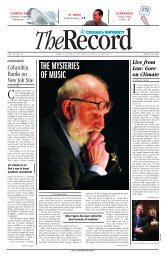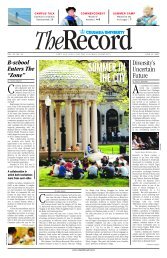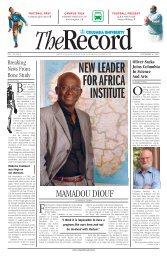January 31, 2011 - Columbia News - Columbia University
January 31, 2011 - Columbia News - Columbia University
January 31, 2011 - Columbia News - Columbia University
You also want an ePaper? Increase the reach of your titles
YUMPU automatically turns print PDFs into web optimized ePapers that Google loves.
4 january <strong>31</strong>, <strong>2011</strong><br />
TheRecord january <strong>31</strong>, <strong>2011</strong><br />
TheRecord<br />
Climate research<br />
Scientists Drill For Insights Under the Salty Dead Sea<br />
By David Funkhouser<br />
Scientists are drilling deep into the bed of the fast-shrinking<br />
Dead Sea, searching for clues to past climate changes<br />
and other events that may have affected human history<br />
even earlier than biblical times. They have found that the sea<br />
has come and gone in the past—a revelation with powerful<br />
implications for the current Mideast.<br />
Bordering Israel and Jordan, the inland Dead Sea is Earth’s<br />
lowest-lying spot on land, with shores some 1,400 feet below<br />
ocean level and hyper-salty waters going down another 1,200<br />
feet or more. Beneath it lie deep deposits of salts and sediments<br />
fed mainly by Jordan River drainage.<br />
The drilling is being conducted<br />
by investigators from Israel, the<br />
United States, Germany, Japan,<br />
Norway and Switzerland.<br />
Steven L. Goldstein, professor<br />
of Earth and Environmental<br />
Sciences and a geochemist at<br />
Lamont-Doherty Earth Observatory,<br />
one of the project leaders,<br />
says that drill cores show that<br />
the Dead Sea has dried up at least<br />
twice without human intervention<br />
over hundreds of thousands of years. “Climate models predict a<br />
greater aridity with a warmer climate,” he noted. “Just imagine<br />
what this means if a warming climate results in the present day<br />
fresh water supply becoming scarcer and scarcer.”<br />
Scarce fresh water is an explosive issue in this part of the<br />
world; the Dead Sea has been shrinking rapidly as Syria, Israel,<br />
Jordan and the Palestinian Authority pull virtually all the<br />
water from the Jordan River for agriculture and other uses. At<br />
its southern end also lie huge evaporation ponds, where Israel<br />
and Jordan mine salt. If changing climate further dries<br />
the region, pressure on the fresh water supply will increase.<br />
Previous research along the Dead Sea’s shores determined<br />
that water levels fluctuated with the coming and going of ice<br />
ages over the last several hundred thousand years. Surrounding<br />
bluffs show higher shorelines; the current sea is more than<br />
800 feet lower than it was during the height of the last glaciation<br />
some 20,000 years ago.<br />
The main drill site is the deepest part of the sea, in about<br />
1,000 feet of water 5 miles off the Israeli shore. Drilling began<br />
Nov. 21 and continued through mid-<strong>January</strong> when it was suspended<br />
for maintenance and repair. It is scheduled to resume<br />
in March. The International Continental Scientific Drilling<br />
Program is sponsoring the project and covering roughly 40<br />
“This is looking at climate<br />
at a very important place<br />
in human history.”<br />
percent of the $2.5 million cost. The remaining funds come<br />
from funding agencies in Israel and the other participating<br />
countries, including the National Science Foundation in the<br />
United States.<br />
Minerals that settle to the bottom of the Dead Sea during<br />
annual dry seasons contain uranium that allows researchers to<br />
date the sediment layers; dry season minerals alternate with layers<br />
of mud formed during the wet seasons. From these deposits,<br />
researchers can find evidence of water chemistry, prevailing<br />
winds and changing climate, not only year by year, but season<br />
by season. At two points, the researchers have already come<br />
across levels composed of pebbles, indicating that the middle<br />
of the Dead Sea was once a beach. These events could coincide<br />
with the end of the last glacial<br />
period around 13,000 to 14,000<br />
years ago, and an earlier interglacial<br />
period 125,000 years ago.<br />
Other levels show evidence<br />
of earthquakes, as layers of sediment<br />
that normally lie flat are<br />
twisted into convoluted shapes.<br />
With precise dating, these should<br />
form a detailed picture of the ancient<br />
history of earthquakes in<br />
the region. “An earthquake was<br />
almost certainly the source of<br />
the biblical story of Jericho, when the walls came tumbling<br />
down,” Goldstein says.<br />
Information from the sediments could form valuable context<br />
for that and other ancient stories. The region is thought<br />
to have been the corridor for various human migrations, and<br />
is the primary route by which early people spread out from<br />
Africa. “This is looking at climate at a very important place in<br />
human history,” Goldstein said.<br />
The chief Israeli scientists on the project are Mordechai<br />
Stein of the Geological Survey of Israel and Zvi Ben-Avraham<br />
of Tel Aviv <strong>University</strong>; others come from the German Research<br />
Center for Geosciences (GFZ), the Hebrew <strong>University</strong> of Jerusalem,<br />
the Swiss Federal Institute of Technology (ETH) in<br />
Zurich, the <strong>University</strong> of Geneva, the International Research<br />
Center for Japanese Studies in Kyoto and the <strong>University</strong> of<br />
Minnesota. The group is hoping to involve scientists from the<br />
Palestinian territories and Jordan as well.<br />
The team hopes to recover cores of sediment going as far<br />
back in time as possible, up to several hundred thousand<br />
years ago.<br />
David Funkhouser is a science writer at Lamont-Doherty Earth<br />
Observatory<br />
Above: Sediment cores taken from the Dead Sea indicate the area has dried up at least twice<br />
without human intervention. The lake faces new stress now from humans pulling fresh water<br />
from the Jordan River, which flows into the sea.<br />
Geology Professor Steven Goldstein stands on a drilling rig in the Dead Sea last November<br />
with a core sample taken from deep below the salty sea between Jordan and Israel.<br />
Goldstein is part of a team of researchers drilling to discover clues to past climate change<br />
and natural disasters in the region.<br />
Adi Torfstein<br />
Adi Torfstein<br />
Law School’s Gerrard Sees Little Hope for Climate Bill This Year<br />
By Bridget O’Brian<br />
Now that Republicans have taken control of the<br />
House of Representatives, a leading expert on climate<br />
change law is not optimistic about the<br />
prospects for meaningful climate legislation in the next<br />
two years.<br />
“The best we can hope for from this Congress is some<br />
energy legislation that would encourage renewable energy<br />
and efficiency”—and even that isn’t a sure thing, says Michael<br />
Gerrard (CC’72), director of <strong>Columbia</strong> Law School’s<br />
Center for Climate Change Law.<br />
The center, which was started in 2009, develops legal<br />
techniques to fight climate change, trains law students and<br />
lawyers in their use, and serves as a clearinghouse for information<br />
about the issue. Gerrard was an environmental<br />
lawyer for 30 years, most recently at the law firm Arnold<br />
& Porter, before becoming the Andrew Sabin Professor of<br />
1<br />
Professional Practice at the law school; he also holds an appointment<br />
at the Earth Institute.<br />
He sees the fight over climate change focusing on the<br />
regulatory authority of the Environmental Protection Agency,<br />
with Congress attempting to suspend or revoke it or<br />
simply to freeze the agency’s funding. Republicans have<br />
already introduced legislation to block the E.P.A.’s ability to<br />
regulate greenhouse gases.<br />
The U.S. Supreme Court held in 2007 that the Clean Air<br />
Act grants the agency the authority to regulate heat-trapping<br />
auto emissions. It was, at the time, a big win for environmentalists.<br />
This year, Gerrard and other climate change<br />
advocates are awaiting the outcome of a case the Supreme<br />
Court recently agreed to hear, Connecticut vs. American<br />
Electric Power.<br />
It was brought by eight states seeking to force five utilities<br />
to reduce their greenhouse gas emissions on the theory<br />
3<br />
20<br />
10<br />
10<br />
21<br />
3<br />
2<br />
1 2 4<br />
1<br />
4 7<br />
1 1 1 2 1 2 1 0<br />
Source: Arnold & Porter and <strong>Columbia</strong> Center for Climate Change Law<br />
Number of Cases<br />
130<br />
120<br />
110<br />
100<br />
Climate Litigation: Filings<br />
Other<br />
Common Law<br />
National Environmental Policy Act<br />
Coal<br />
Industry<br />
Environmentalist<br />
12 9<br />
4 6<br />
1989 1992 1993 1996 1997 2001 2002 2003 2004 2005 2006 2007 2008 2009 2010<br />
90<br />
80<br />
70<br />
60<br />
50<br />
40<br />
30<br />
A chart shows how lawsuits related to climate change have skyrocketed in recent<br />
years, with the majority filed by industry seeking to overturn EPA rules<br />
1<br />
3<br />
10<br />
22<br />
Year Filed<br />
3<br />
1<br />
14<br />
32<br />
4<br />
22<br />
15<br />
4 9<br />
8<br />
9<br />
13<br />
96<br />
( 372 c a s e s a s o f<br />
J a n . 5 , <strong>2011</strong> )<br />
that they are a public nuisance. In 2009, the 2nd U.S. Circuit<br />
Court of Appeals court ruled in favor of the states. This theory<br />
could open up liability claims against not only electric<br />
utilities, but also a broad swath of industries.<br />
It could be the Court’s most important environmental<br />
decision since the 2007 case, Massachusetts v. EPA.<br />
“This will be very big,” Gerrard says. “We know the<br />
four justices who dissented in that case would want to<br />
reverse this current case.” He was referring to Chief Justice<br />
John G. Roberts Jr. and Justices Antonin Scalia, Clarence<br />
Thomas and Samuel A. Alito Jr.<br />
The outcome of the Connecticut case is uncertain in part<br />
because Justice Sonia Sotomayor has recused herself due to<br />
her involvement in the case at the appellate level, and a 4-4<br />
tie is possible.<br />
Gerrard notes that in addition to the Supreme Court action,<br />
lawsuits related to climate change have skyrocketed.<br />
According to the database of the Center for Climate Change<br />
Law, 132 lawsuits were filed in U.S. courts in 2010 compared<br />
to 54 in 2009. The majority, 96, were filed by industry firms<br />
seeking to overturn the E.P.A.’s regulations concerning<br />
greenhouse gas emissions. Just a handful were filed by environmentalists.<br />
“Coal-fired plants are the largest single source of greenhouse<br />
gases in the United States so the environmental community<br />
has launched a campaign to stop the construction<br />
of any new coal plants, and it’s been very successful so far,”<br />
Gerrard says.<br />
Unlike tax or bankruptcy law, there isn’t one statute governing<br />
climate change, nor are there specific laws on the<br />
books as yet to address climate change.<br />
Those difficulties stem from the very nature of climate<br />
change. “It involves a broad range of human activities that<br />
have a cumulative impact over time and over space all over<br />
the world,” says Gerrard.<br />
“Reducing greenhouse gas emissions in any one location<br />
will not have a local or immediate effect, but it will contribute<br />
overall to the eventual solution of the problem.”<br />
Advocates for climate change legislation have their work<br />
cut out for them over the next couple years as they contend<br />
with a new crop of lawmakers hostile to the idea of regulating<br />
emissions. In addition to introducing anti-regulatory<br />
bills, House climate change skeptics are expected to launch<br />
investigations challenging scientific research on the topic.<br />
“The 2012 election could bring a whole new ball game,”<br />
says Gerrard. “It could get better, it could get worse.”






